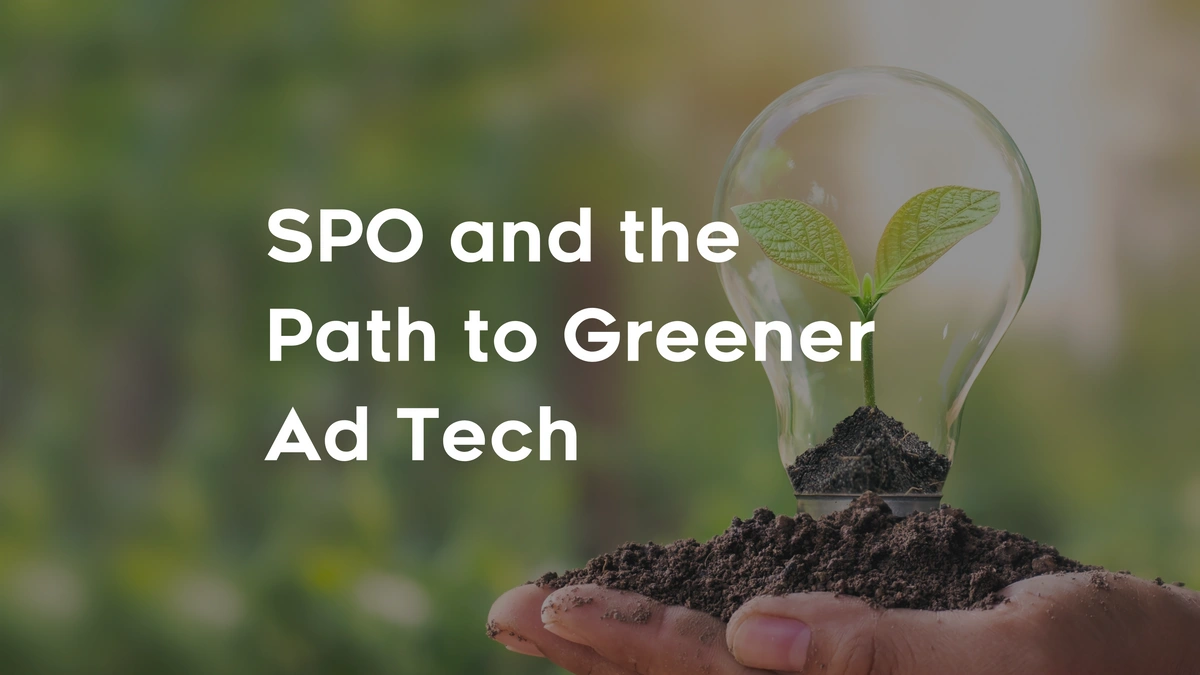


SPO and the Path to Greener Ad Tech
Advertising technology is built on the promise that there are more efficient ways to carry out planning, buying, and measurement across the vast digital media ecosystem. As advertising has become a data-driven medium, advertisers have relied more and more on various platforms – especially programmatic tools – to deliver granularly-targeted, high-ROI campaigns.
Marketers were clearly early to appreciate this efficiency: Digital media will account for nearly 75% of all U.S. media spending this year. More than half of that is display advertising, and 90% of display dollars go through programmatic. In 2022, that represented more than $115 billion dollars.
But that efficiency comes at a price. Programmatic media requires computing power. No, it is not on the same scale of environmental impact as cryptocurrency mining, but because engaging multiple ecosystem partners is not cost prohibitive, redundancies have crept into the process, and an ecosystem reliant on mass housing and distribution of data has blossomed.
Programmatic systems were designed to reward a shotgun approach. Without getting overly technical, the mass deterministic data sets housed in DMP marketplaces fuels a “shotgun” approach to open exchange inventory and addressability, with no focus on its eco-impacts. As data increasingly shifts from the buy-side to the sell-side, a fortuitous “byproduct” is that sell-side data, especially when delivered in real-time, is not only more efficient for the buyers, but also far cleaner and more environmentally friendly.
The Programmatic Supply Chain
Originally, programmatic was designed to connect advertisers with demand from across the web, especially the long-tail. At the same time, these pipes would allow publishers to open-up their inventory and audience to a wider array of buyers. This was more than appealing to smaller long-tail publishers who had deeply-engaged niche audiences, but might not have the scale to build-out direct ad sales teams.
Buyers would use demand-side platforms (DSPs) to apply parameters and purchase inventory. Sellers would use supply-side platforms (SSPs) to package up their inventory and make it easy to access. SSPs and DSPs would connect to each other, forming a technology layer that created the marketplace efficiencies.
As programmatic evolved, more and more layers developed between the buyer and the seller. Publishers might use one platform to manage their supply, but then aggregators appeared, packaging inventory from across several SSPs and then selling that to DSPs while taking a margin. Connecting all of these hops was data (cookies, MAIDs and other identifiers) which would need to be aggregated, housed, distributed and matched in hosted matching tables to connect all of these disparate platforms. With new offerings promising incremental revenue, the supply chain grew more complicated and publishers saw less and less of each dollar spent. At the same time, advertisers saw a greater percentage of their ad spend go towards intermediaries, rather than towards ad inventory.
For every platform and hop that an ad impression took and all of the additional layers needed to make that impression’s addressability even possible, additional computing was required. The same holds true every time an ad impression was made available across multiple SSPs and received multiple bids – sometimes from the same buyer bidding against itself. The net result was bad for publishers, advertisers, and the environment.
Cleaning Up The Supply Path
In recent years, we’ve seen increased interest in SPO to clean up the supply path, eliminate unnecessary bids, and reduce the number of intermediaries who claim a portion of their budget. In the process, advertisers also wanted to once again be closer to publishers to better support the environments required for premium placements. SPO is the practice of purchasing inventory through a highly-efficient path, minimizing intermediaries between buyer and seller to deliver more value to both advertiser and publisher while drastically reducing the “ad tech tax.”
Beyond creating more efficiencies for brands and ensuring more dollars flow to publishers, the unspoken benefit of SPO is that by clearing out some of those hops and the required requisite computing, SPO creates a greener ad tech ecosystem. Streamlining the number of parallel bid requests for the same impression along the supply path automatically also cuts the total carbon emissions generated by programmatic ad buys. Fewer ad calls for each impression means the amount of energy for each impression is cut significantly. Efficient digital supply paths that ping fewer servers minimize the energy involved, providing brands and agencies a tangible option that reduces the environmental impact of a large percentage of their programmatic advertising.
Beyond that, the fewer hops and platforms and the more data directly applied to supply from the sell side, the less data that needs to be shipped everywhere, the fewer matching tables hosted, and the less data stored, creating a smaller carbon footprint.
Curation As An SPO Tool
Fortunately for marketers – and the environment – tools are emerging that make SPO even more accessible. Chief among these is curation, the practice of matching premium inventory with data driven audience intelligence and delivering to buyers via PMPs versus old-school DMP segments.
Curation largely happens within multi-publisher, private marketplaces (PMPs), which adds controls early in the programmatic buying process, streamlining the number of hops as a prerequisite. This has proven to be a more effective approach to programmatic, and SPO is an added benefit. Beyond that, applying data directly to the supply path cuts down on the amount of data that needs to be housed and distributed daily.1-to-1 per each deal versus the shotgun approach of DMP segments which requires massive redundancies.
By leveraging supply-path optimization through curated deals, advertisers access the most direct, efficient path to the end publisher, thereby reducing their ad-tech costs while increasing the amount of revenue (CPMs) to the publisher. Win-win. This combination of curation driving SPO will help advertisers efficiently reach their audiences now, and even into the future once third-party cookies have been deprecated. Especially as data integrations move to real-time connections between SSPs and data companies, the amount of data that will need to be shipped daily will be significantly reduced.
“Programmatic ad buying introduced a great deal of ease and efficiency to the market, but over time the convoluted supply path created the hidden ad tech tax. What we’re realizing now is that the environment pays this tax just as much as advertisers do,” said John Osborn. “Curation and SPO are approaches that can demonstrably improve performance and efficiency across all advertising channels while also delivering a tangible positive impact on the environment.”
Thinking about SPO is a sound strategy for marketers as we enter 2024. While they consider SPO as a tool for driving efficiency and efficacy, they should think about it as a best practice for creating a greener, more eco-friendly ad tech ecosystem. The more thoughtful advertisers are about their supply paths, the more benefit they’ll do for not only brands and publishers, but the world around us - and that’s a win-win-win for advertisers, publishers and the environment.
